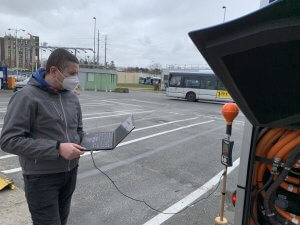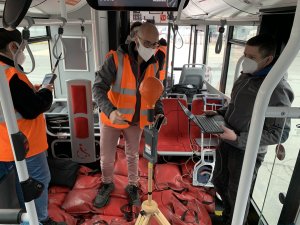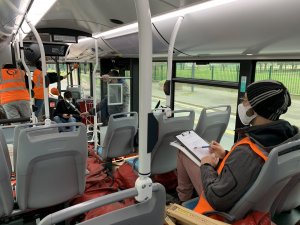Measurement of Human Exposure to Electromagnetic Fields on Electric Buses
Eurailtest and the Test and Measurement Laboratory (LEM) have again been asked to provide their skills and expertise to conduct measurement tests on human exposure to electromagnetic fields as part of the ‘Bus 2025’ project. This project, initiated by the RATP in 2014, aims to convert the fleet of buses in the Ile-de-France region to run on electricity and renewable gas.
The deployment of collective mobility solutions powered by electricity is about delivering significant gains in both comfort and pollution reduction. However, as new technologies emerge, additional parameters need to be monitored, with a specific focus on human exposure.
Identification of Emission Sources
In order to measure human exposure to electric and magnetic fields, a layout plan of the measuring points must be consulted. This plan identifies all the electromagnetic field emission sources (cables, batteries, etc.) inside and outside the bus.
Measurement Procedure for Checking Public Exposure to Electromagnetic Fields
The LEM had already conducted tests in September 2020 to measure human exposure to electromagnetic fields on the new fleet of electric buses.
A new measurement campaign was conducted by our partner laboratory, the LEM, on an electric bus. The purpose of these tests is to check that the limitations of exposure of both the public and workers to electromagnetic fields are observed.
These limitations are defined in Recommendation 1999/519/EC of 12/07/99 for the general public and Directive 2013/35/EU on the minimum health and safety requirements regarding the exposure of workers.
Static measurements were conducted at the RATP Bus Centre in Saint-Maur Créteil and dynamic measurements were performed on the TVM line (Trans-Val-de-Marne).
Static Tests:
Static tests are conducted when the bus is stationary, in operational configuration with traction drive active. With the aid of electromagnetic probes connected to a field meter, experts measure the electromagnetic field levels emitted by equipment located around and inside the bus at previously identified measurement points.


Dynamic Tests:
Dynamic measurements are performed on a section of the Trans-Val-de-Marne (TVM) bus line, with a bus loaded to its permissible GVW (Gross Vehicle Weight) using ballast positioned across the floor inside the bus. This load is used to simulate the weight of passengers.
As with the static tests, the various dynamic measurements are performed inside the bus at different points and heights, using French standard EN 50500 for guidance.
The values of the measured fields are read when the traction drive is pushed to its maximum, during acceleration and braking.


*The results are expressed as a percentage of the threshold value to be observed: 100% being the maximum value that must not be exceeded.
The emissions must cause no risk to any category of person:
- General public: Individuals of all ages and all states of health (including newborn babies, children and elderly people)
- Workers: Two categories of workers are identified:
-Low-risk workers
-High-risk workers (pregnant women, people with active and passive medical implants, etc.)
The LEM team delivered its expertise, skills and measuring services to the RATP, ensuring that all regulations on human exposure were observed, in light of the new technologies requiring the monitoring of additional parameters.
The Eurailtest and LEM teams offer a range of measurement services, including infrastructure electromagnetic compatibility, as well as rolling stock and railway system electromagnetic compatibility.





 FR
FR